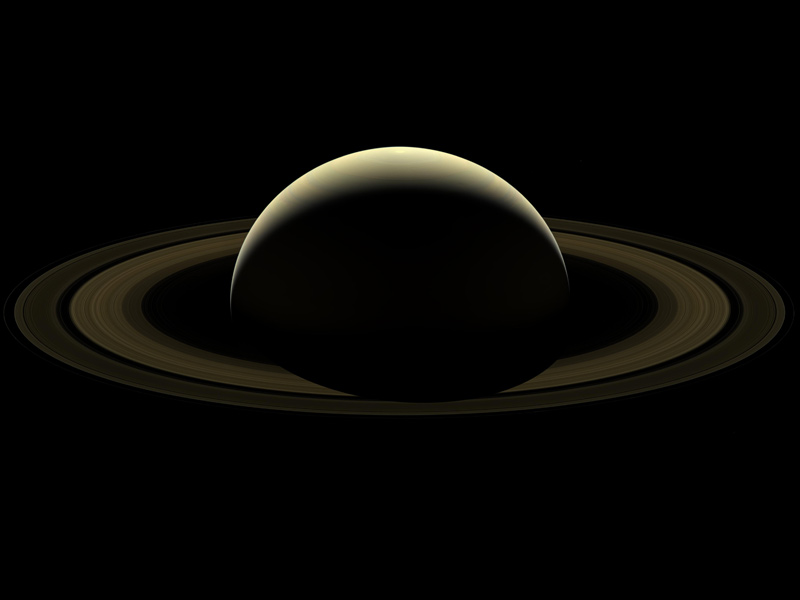It is time to watch the “Lord of the Rings” as soon as once more.
In case you step exterior on Thursday (Aug. 11) and look towards the east-southeast horizon shortly after 9 pm native time, you may see the August full moon slowly ascending the sky. And as you watch, take be aware additionally of a brilliant yellow-white “star” shining to the moon’s higher left.
Besides that is not a star, however fairly presumably essentially the most spectacular planet in our photo voltaic system: The ringed marvel, Saturn.
Associated: Saturn’s Rings: Composition, Traits & Creation
By round after midnight, you may see that Saturn could have shifted to a place nearly immediately above the moon as the 2 seem one-third up from the south-southeast horizon to the purpose immediately overhead (the zenith). Usually this may even be the night time when most stargazers could be intent on anticipating Perseid meteors, however sadly this yr that very same brilliant moon will act like a celestial highlight, lighting up the sky and squelching the sunshine of all however the very brightest meteor streaks .
So, maybe as a comfort prize, we must always flip our consideration to Saturn, generally dubbed the “telescopic showpiece of the night time sky.”
Nevertheless, that out of the 5 brightest planets, Saturn appears to be the least alluring to the bare eye. Mercury, for instance, is the speediest planet, shifting quickly back-and-forth from one aspect of the solar to the opposite. Venus is by far and away the brightest of the 5, glowing brilliantly, form of like a celestial night time mild, both within the east at daybreak or within the west at nightfall. Mars is essentially the most colourful, shining a fiery yellow-orange, whereas Jupiter, although not as sensible as Venus, can seem to dominate the sky all by way of the night time.
Gradual and sheepish
And Saturn? Visually there may be nothing actually distinctive about it to make it stand out. If for nothing else, its most revealing attribute was that it was by far the slowest of the recognized planets. The age-old astronomers of hundreds of years in the past regarded Saturn because the “highest” planet, occupying the outermost or highest sphere earlier than that of the mounted stars.
In historic days, earlier than we had data of the extra distant planets Uranus, and Neptune, Saturn was presumed to be the farthest and slowest-moving recognized planet and therefore reminded historic skywatchers of the Greek god Cronus, the god of time. However he is extra often acknowledged because the Roman god of agriculture.
The title is expounded to each the noun satus (seed corn) and the verb serere (to sow).
However why would the planet Saturn be linked to agriculture? Maybe a clue could be discovered from the Assyrians who referred to Saturn as lubadsagush, which translated, meant “oldest of the outdated sheep.” Presumably this title was utilized as a result of Saturn appears to maneuver so very slowly among the many stars; it might have additionally reminded skywatchers of the gradual gait of plowing oxen or cattle.
Certainly, since Saturn requires 29.5 years to orbit the Solar, its progress by way of the zodiacal constellations is kind of gradual, averaging 2.5 years per constellation. Presently we discover it inside the jap portion of the considerably dim star sample of Capricornus the Sea Goat. The final time this planet occupied this a part of the sky was early in 1993.

A telescope makes a giant distinction
Sure, seen with solely your bare eye, Saturn seems solely as a brilliant golden star shining with a gentle glow; nothing that basically calls your consideration to it. However the ring system that makes it each lovely and spectacular can’t be seen. To indicate the rings you’ll need both high-powered binoculars (mounted on a sturdy tripod) or a small telescope magnifying not less than 25-power. After all, bigger telescopes using greater magnifications will make the view growing spectacular; the bigger the aperture and the sharper the picture, the extra element you can also make out.
Even in small telescopes, they shock observers with their chilling magnificence and icy, glimmering magnificence, despite the truth that it’s anticipated. If in case you have a 2.4-inch telescope, your finest view of Saturn will come at 60-power. With a 3-inch telescope, strive 75-power; with a 6-inch, 150-power is an efficient alternative.
Once I’m displaying off Saturn in my 10.1-inch Dobsonian reflector, I often use a magnification of 250-power. The most effective reactions come from those that have by no means seen it by way of a telescope. What often follows are exclamations of astonishment and delight:
“No method!”
“Oh my god!”
“That is superior!”
And on a couple of event, I’ve been accused of displaying a slide of Saturn upon gazing by way of the eyepiece of my telescope. “Nope,” I inform the disbelieving viewer, “What you are taking a look at is the true factor.”
Whereas they give the impression of being strong, the rings really include billions of particles — largely water ice — that vary in dimension from microscopic specks to flying mountains miles throughout. Every particle revolves round Saturn in its personal orbit; seemingly they’re icy fragments of a satellite tv for pc that in all probability ventured too near Saturn and was torn aside by tidal forces.
The rings are at the moment tilted 14 levels towards Earth and nonetheless present up fairly properly. Sadly, within the years to come back, they’ll finally shut to some extent the place by the spring of 2025 they’ll flip edgewise towards the solar and Earth and turn into all however unattainable to see.
See it now!
Now could be one of the best time to look at Saturn. On Sunday night time (Aug. 14), Saturn arrives at opposition, when it lies on the alternative aspect of the sky from the solar. That is additionally when its obvious dimension is best, and so it levels an all-night efficiency with best gleam. It now could be rising because the solar units, reaches its highest level within the southern sky round 1 am (native daylight time) and units when the solar rises. When at opposition, Saturn can also be at its closest level in its orbit relative to the Earth for this yr: 823 million miles (1.32 billion km) away. It at the moment shines at a respectfully brilliant magnitude of +0.3; that is only a trifle brighter than the equally coloured winter star Procyon, which ranks eighth among the many 21 brightest stars within the sky.
However even after its midsummer opposition, Saturn will nonetheless be in fantastic place to be seen proper on by way of the top of this yr. By the second week of October, it will likely be peaking due south at round 9 pm native daylight time. And even round Christmas you may nonetheless have the ability to discover it at dusk low within the southwest sky till it units round to eight:30 pm
Ultimate factoids
Along with the rings, Saturn, eventually rely, has 82 moons. Of those, fifty-three are confirmed and named, whereas the opposite 29 are nonetheless pending affirmation of discovery and official naming. Saturn’s moons vary broadly in dimension. The biggest is Titan, 3,200 miles (5,150 km) in diameter and the second largest pure satellite tv for pc within the photo voltaic system; bigger even than the planet Mercury. It is usually the one recognized moon with a big ambiance, consisting primarily of organonitrogen compounds. As for the smallest moons of Saturn, they seemingly are not any bigger than just a few hundred toes throughout.
The theoretical development of Saturn — 74,900 miles (120,500 km) broad — resembles that of Jupiter; it’s both all gasoline, or has a small dense heart surrounded by a layer of liquid and a deep ambiance. And since its particular gravity is lower than that of water, Saturn would float — should you may solely discover an ocean massive sufficient to drop it in!
Joe Rao serves as an teacher and visitor lecturer at New York’s Hayden Planetarium (opens in new tab). He writes about astronomy for Pure Historical past journal (opens in new tab)the Farmers’ Almanac (opens in new tab) and different publications. Comply with us on Twitter @Spacedotcom (opens in new tab) and on Fb (opens in new tab).
